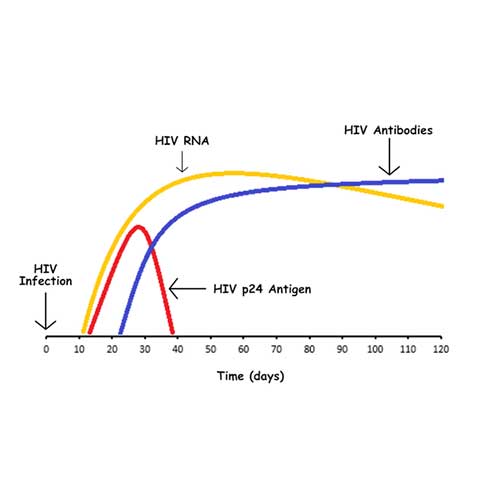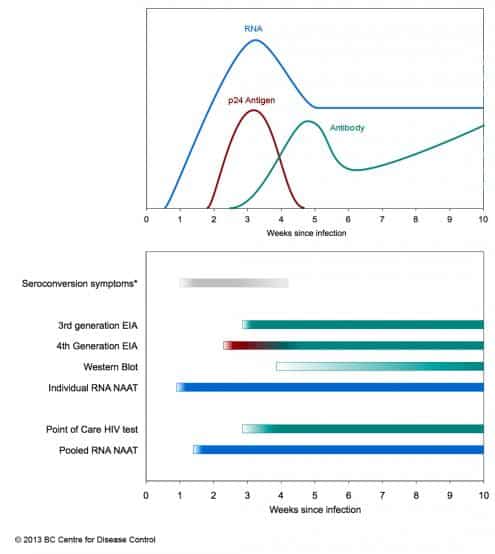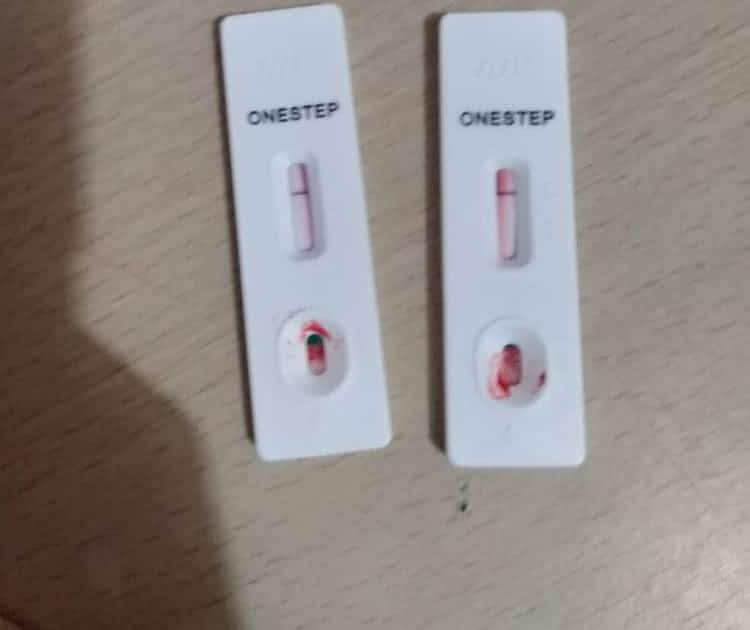Testing After An Exposure Event
HIV testing is often prompted by a defined exposure, such as a needlestick injury, condom failure, or condomless sex. Because no diagnostic test is capable of detecting infection in the eclipse period, baseline testing is obtained to rule out undiagnosed, pre-existing infection in the patient. Blood-based POC testing should be used whenever possible, in order to facilitate prompt initiation of post-exposure prophylaxis .26,27 Strong preference should be given to an Ag/Ab combination test over antibody-only options, and oral fluid should not be used. Follow-up testing should occur 46 weeks and 3 months after baseline, with additional testing at 6 months if the exposure event resulted in hepatitis C virus infection.27 If the patient tests negative at the end of the window period , one can be very confident that s/he did not acquire HIV from the exposure.
Interpretation Of Serological Test Results
Negative HIV serological testing in an infant, following nationally validated testing algorithms, suggests the following:
- The infant is not HIV-exposed or
- The infant is HIV-exposed but has seroreverted or
- If the infant has never been breastfed or not breastfed in the past 6 weeks, the infant is HIV uninfected.
If the infant is still breastfeeding, a negative HIV serological test result cannot exclude HIV infection.
Positive or reactive HIV serological testing in an infant suggests the following:
- The infant is HIV-exposed and /or
- The infant may be HIV-infected the older the infant, the more likely the infant is of being HIV-infected.
For the purposes of testing in children in relation to breastfeeding, the window period required before serological testing can be reliably interpreted after cessation of breastfeeding using rapid tests or EIA is recommended to be 6 weeks. Isolated case reports of false-negative rapid HIV tests in sick children who then go on to being HIV-infected need to be investigated.
Stages Of Hiv Infection
HIV infection is categorized according to the severeness of the symptoms exhibited.
The first stage is termed Acute HIV infection where the virus has just entered the body and begun to manipulate.
The second stage is known as Chronic HIV, this is the stage when some people start experiencing actual symptoms of the disease, by now the infection has started to spread rapidly.
The final stage is known as AIDS , where the immune system is totally weakened and the infected person is open to acquire any disease otherwise a healthy person does not get affected easily.
Read Also: Which Blood Test For Hiv
Window Period Of Hiv Tests
The window period refers to the time between HIV infection and when a test can detect HIV infection, which varies between individuals and depends on the target being detected by the test.The event of possible HIV exposure must took place after the window period of the HIV test in order to get an accurate result. For example, if you had sex 20 days ago, the HIV combo test or HIV RNA test can be use but not the rapid HIV antibody test .
| HIV Tests |
| 90 days |
Outreach Testing In Developed Countries

Mobile testing units, syringe exchange programs, and community testing events place a premium on test portability, ease of administration, flexibility in specimen type, and rapid turnaround of results all of which make POC tests an obvious, frequent choice. However, longer window periods and lower sensitivities with POC assays compared to their laboratory-based counterparts are important trade-offs to consider. Because some outreach testing populations may be more likely to have recent HIV infection, IgM/IgG sensitive POC tests should be prioritized over those capable of detecting IgG only. Whenever logistically feasible, serum or plasma should be tested instead of whole blood, and consideration should be given to sending a specimen for laboratory platform testing in addition to the POC test. Oral transudate should be used as a specimen only when obtaining blood is impractical or undesirable.13 Patients and testing clients considering oral HIV self-testing should be counseled about its longer window period compared to either blood-based POC tests or laboratory-based assays.
You May Like: Can I Get An Hiv Test At Walgreens
Also Check: Can You Get Hiv From Someone Who Doesnt Have Hiv
How To Prevent Hiv
For diseases that dont have any cure, it is always better to take self precautionary measures than worrying to get tested for STDs after unprotected sex. Unlike other diseases, there is no vaccine to cure HIV/AIDS infection. The following are some of the methods to prevent HIV
- Regular HIV testing
- Practicing sex with your wife only avoid having sex with strangers
- Always use a new and clean needle to inject the drugs and while blood donation/transfusion
- Sharing the knowledge of HIV to your sex partners and encouraging them to get tested.
What Are The Different Types Of Hiv Tests
The window period and accuracy for HIV testing varies by test and the bodys individual immune response. The following are types of HIV tests, window periods for each, and accuracy information.
Generally, tests that use blood from a lab draw deliver accurate results sooner than tests that use finger pricks or oral swabs.
Also Check: Is There S Cure For Hiv
First Stage: Acute Hiv
Acute HIV usually shows little-no symptoms of the disease. Fever, headache, and fatigue which flu-like symptoms shown in the first stage. It may take up to 2 3 weeks for the symptoms to occur after the initial exposure. In the Acute stage, the HIV virus is in tiny quantities that make the regular tests undetectable. You may not experience the symptoms until the virus gets manipulated massively. Some people will get to know only when the infection reaches the Chronic HIV stage.
Symptoms of Acute HIV infection include
Hiv Rna Early Detection Test
Read Also: Can Hiv Be Transmitted Through Mosquito Bites
Results Reporting Critical Findings
Once HIV is diagnosed, it is essential to link patients who are HIV-positive to the care they need. The CDC uses the HIV care continuum to explain that only 30% of the 1 million adults living with HIV in the United States are in treatment, adhering to medication therapy, and achieving viral control. Data from 2011 shows that only 86% of HIV-positive adults are diagnosed, 40% are linked to a provider, 37% are prescribed antiretroviral therapy, and 30% adhere to the medications to achieve viral suppression. The care continuum is a motivating tool for healthcare providers to intervene at every level of HIV care to improve outcomes. HIV can be treated in a variety of settings including primary care, infectious disease specialty offices, federally qualified health centers, and specific HIV care centers. Every practice that screens for HIV should develop a relationship with a treating office and follow up with patients concerning their linkage to care.
What Is Hiv Rna Early Detection Testing
An HIV early detection test, or a viral load test, is used to identify a recent exposure to the human immunodeficiency virus . While regular antibody testing is only accurate about 2 months after transmission, HIV RNA testing can detect the infection as soon as 10 days after transmission.
Currently, there is no cure for HIV.1 However, modern medicine and early testing options allow people with this STD to live long, happy lives. Because of this, Priority STD offers easy, early detection HIV testing online.
Order
Purchase your STD lab order privately online or over the phone. The process is simple, quick, and secure. Our care counselors are available to answer any questions you may have or help schedule STD testing.
Recommended Reading: What Is Confidential Hiv Testing
Which Test Is Which
Figure 11 lists commonly used HIV tests and shows what type of test they are.
Your testing centre should tell you this information for the test that they use.
Sometimes testing centres give the tests explained above different names like ELISA or Western blot without explaining what kind of test they are and what it is they are looking for.
ELI, MEIA, ELFA, ECLIA use similar technology to ELISA tests.
UK guidelines recommend using 4th generation tests but 5% of clinics still use 3rd generation tests.
Ask your clinic for more detailed information about the type of test that they use.
Mycoplasma And Ureaplasma Testing

The incubation period for Mycoplasma Genitalium varies from 2 to 35 days.12 Incubation period for Ureaplasma constitutes 10-20 days.13 Common practice suggests testing for Mycoplasma and Ureaplasma only when the other pathogens causing the urethral infection are excluded. 14 Collection of swabs or urine is the best option if you want to get tested.15
Also Check: Is Hiv An Infectious Disease
What To Expect With Hiv Testing
For a lab test, you might need to call your doctor to schedule it. Some public health- clinics take walk-ins.
A technician will take a small blood sample and send it to a lab. Some immunoassay tests check your urine or fluids from your mouth , but there aren’t as many antibodies in these, so you may get false negatives.
With home blood tests, you prick your finger to get a small blood sample that you send to a lab. You call to get your result, and you don’t have to give your name. If it’s positive, the lab will also do a follow-up test to double-check.
With home oral fluid tests, you swab your upper and lower gums and test the sample in a vial. About 1 in 12 people who are infected get a false negative from this test. If itâs positive, get a lab test to confirm.
How long does it take to get HIV results? This depends on what kind of test you had. Rapid tests provide answers in less than a half-hour. With a standard blood test or antibody/antigen test, you should expect results in a few days. It may take several days to get results from an NAT test. Urine test results could take up to 2 weeks.
Dried Blood Spot Test
A DBS test is a free, accurate and convenient way to test for HIV in the comfort and privacy of your home.
It involves collecting a few drops of blood from your finger and allowing the blood to dry on a test card. You then send the card away to get tested and wait around a week to get the result back. You can register for a DBS HIV test here.
Read Also: Does Magic Still Have Hiv
Rna Tests Or Viral Load Test
Polymerase Chain Reaction Test or viral load test directly look for HIV in blood. The HIV viral load is the number of copies of the HIV in your blood and other parts of your body. Because the test has shortest window period i.e 9-11 days, it is used to detect HIV infection at an early stage. This is the most popular HIV test in the United States for HIV early detection.
When someone get exposed to an HIV infection, the viral load is usually very high within the first 4 weeks. If someone shows HIV symptoms, this can be used to confirm a suspected early infection.
How Does An Hiv Test Work
An HIV test looks for evidence of HIV in your blood or oral fluid. This evidence may be the virus itself, HIV antigens and antibodies, or just the antibodies. Additional testing will be needed to confirm the results if you test positive. If you test negative, this means that you likely dont have the virus. To trust the results, youll need to be sure that you took the test at the right time to detect the virus. It takes some time after youve been exposed to the virus for an HIV test to detect it.
Read Also: Labcorp Hiv Test Turnaround Time
Is This Test Included In Any Screens
The HIV 1 RNA test is available as part of our Early Detection Screen which tests for HIV, Hepatitis B and Hepatitis C. Your results will be ready just 3 working days from when your sample is received in our laboratory. Our comprehensive Early Platinum Screen includes a 10-Day HIV test in addition to testing for many other infections.
Window Period Of Hiv Rna Test
Our HIV RNA detection system is an enclosed, fully automatic system and result is available within a few hours. The earliest detection of HIV RNA is about 7 days post exposure. Research suggested that an HIV RNA test with a sensitively of 50 copies/ml would detect HIV infection approximately 7 days before a p24 antigen/antibody test . There is currently no research evidence to support the use of HIV RNA test less than 7 days post exposure.
The HIV RNA Test is not recommended for diagnostic purposes alone. The result of the 4th generation HIV test should be used together to determine infection status, especially the cases with low HIV RNA level.
Read Also: How Long Does It Take To Get Hiv Test Results
When Is The Test For Hiv False
Likelihood of false-negative results is high if you took the test during the window period. To avoid false-negative results, you should repeat the test after the window period. If the initial testing was during the first 12 weeks after possible exposure, the test should be repeated after an extra 12 weeks for more reliable results.6
Why Wait For 9

HIV is a virus that stores its genetic information in an RNA instead of DNA. This genetic information or material does not develop up slowly unlike antigens and antibodies but it is already present in your body as soon as the contraction of HIV and the viral load of the virus is usually high enough in such a way that it is detectable within 9 to 11 days.
Recommended Reading: Can Hiv Positive Woman Donate Eggs
On The Duration Of The Period Between Exposure To Hiv And Detectable Infection
Use stochastic modelling to study the first days of HIV infection.
-
Model fit to HIV viral load data from 78 seroconverting plasma donors.
-
Obtain the duration of the eclipse phase between exposure and detectable infection.
-
Estimate the eclipse phase to last no more than 8 to 10 days in most cases.
What Are The Signs And Symptoms Of Hiv
The most common symptoms of HIV in men & women include
- Persistent headache
Though the symptoms of HIV do not show initially, the virus maintains a low profile and keeps manipulating and damaging the CD4 immune cells. Some people may experience the symptoms after 14 days or later and some may not notice the symptoms even for years. So, it is highly recommendable to get tested for HIV RNA if you experience the above symptoms and having multiple sex partners.
Recommended Reading: Bose Soundcontrol Hearing Aids Reviews
What Is The Treatment For Hiv
If tested positive for HIV, do not panic. Keep calm and react accordingly as per the stage of your HIV infection. You are lucky if you had detected the infection at an early stage, you can get diagnosed and treated. But, there is no cure for advanced AIDS/HIV infection. Anti-retroviral drugs are used for HIV treatment. This treatment is called antiretroviral therapy. Anti-retroviral drugs help in controlling the virus and reduce the symptoms exhibited.
This therapy plays a vital role not only for the treatment of severe HIV infection but for people being treated for Hepatitis B or C, and people having low CD4 cell count.
What Is Being Tested
Human immunodeficiency virus is the virus that can cause acquired immunodeficiency syndrome . HIV screening tests detect the HIV antigen and/or HIV antibodies produced by the body in response to an HIV infection in the blood. Some tests detect HIV antibodies in saliva.
An HIV infection may initially cause no symptoms or cause flu-like symptoms that resolve after a week or two. The only way to determine whether you have been infected is through HIV testing.
If left untreated, an HIV infection can progressively destroy the bodys ability to fight infections and certain cancers. HIV weakens the immune system by infecting lymphocytes , a type of white blood cell, that normally help the body fight infections.
During the first few weeks following infection with HIV, the virus infects T-cells, making numerous copies of itself and continuing to infect more T-cells. The amount of virus and the p24 antigen level in blood can be quite high. HIV tests that detect the p24 antigen can generally identify infections in the first weeks after infection, even before antibodies develop.
About 2-8 weeks after exposure to the virus, the immune system responds by producing antibodies directed against the virus that can be detected in the blood. As the initial infection resolves and the level of HIV antibody increases, both virus and p24 antigen levels decrease in the blood. HIV tests that detect HIV antibodies can identify HIV infections about 2 to 8 weeks after infection.
Don’t Miss: What To Do When Condom Breaks To Prevent Hiv